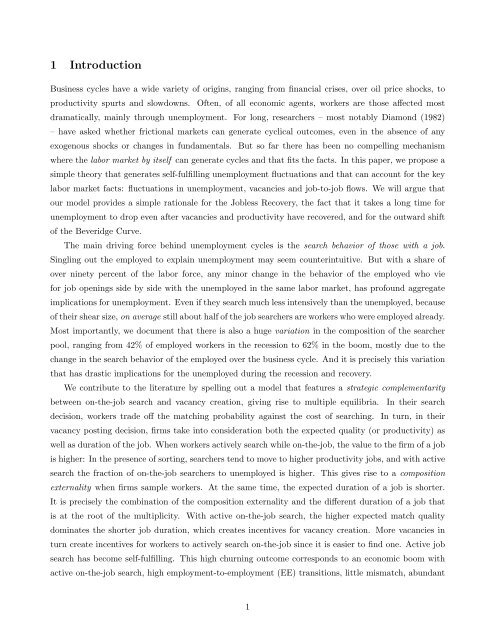Unemployment cycles
WP201526
WP201526
Create successful ePaper yourself
Turn your PDF publications into a flip-book with our unique Google optimized e-Paper software.
1 Introduction<br />
Business <strong>cycles</strong> have a wide variety of origins, ranging from financial crises, over oil price shocks, to<br />
productivity spurts and slowdowns. Often, of all economic agents, workers are those affected most<br />
dramatically, mainly through unemployment. For long, researchers – most notably Diamond (1982)<br />
– have asked whether frictional markets can generate cyclical outcomes, even in the absence of any<br />
exogenous shocks or changes in fundamentals. But so far there has been no compelling mechanism<br />
where the labor market by itself can generate <strong>cycles</strong> and that fits the facts. In this paper, we propose a<br />
simple theory that generates self-fulfilling unemployment fluctuations and that can account for the key<br />
labor market facts: fluctuations in unemployment, vacancies and job-to-job flows. We will argue that<br />
our model provides a simple rationale for the Jobless Recovery, the fact that it takes a long time for<br />
unemployment to drop even after vacancies and productivity have recovered, and for the outward shift<br />
of the Beveridge Curve.<br />
The main driving force behind unemployment <strong>cycles</strong> is the search behavior of those with a job.<br />
Singling out the employed to explain unemployment may seem counterintuitive. But with a share of<br />
over ninety percent of the labor force, any minor change in the behavior of the employed who vie<br />
for job openings side by side with the unemployed in the same labor market, has profound aggregate<br />
implications for unemployment. Even if they search much less intensively than the unemployed, because<br />
of their shear size, on average still about half of the job searchers are workers who were employed already.<br />
Most importantly, we document that there is also a huge variation in the composition of the searcher<br />
pool, ranging from 42% of employed workers in the recession to 62% in the boom, mostly due to the<br />
change in the search behavior of the employed over the business cycle. And it is precisely this variation<br />
that has drastic implications for the unemployed during the recession and recovery.<br />
We contribute to the literature by spelling out a model that features a strategic complementarity<br />
between on-the-job search and vacancy creation, giving rise to multiple equilibria. In their search<br />
decision, workers trade off the matching probability against the cost of searching. In turn, in their<br />
vacancy posting decision, firms take into consideration both the expected quality (or productivity) as<br />
well as duration of the job. When workers actively search while on-the-job, the value to the firm of a job<br />
is higher: In the presence of sorting, searchers tend to move to higher productivity jobs, and with active<br />
search the fraction of on-the-job searchers to unemployed is higher. This gives rise to a composition<br />
externality when firms sample workers. At the same time, the expected duration of a job is shorter.<br />
It is precisely the combination of the composition externality and the different duration of a job that<br />
is at the root of the multiplicity. With active on-the-job search, the higher expected match quality<br />
dominates the shorter job duration, which creates incentives for vacancy creation. More vacancies in<br />
turn create incentives for workers to actively search on-the-job since it is easier to find one. Active job<br />
search has become self-fulfilling. This high churning outcome corresponds to an economic boom with<br />
active on-the-job search, high employment-to-employment (EE) transitions, little mismatch, abundant<br />
1


